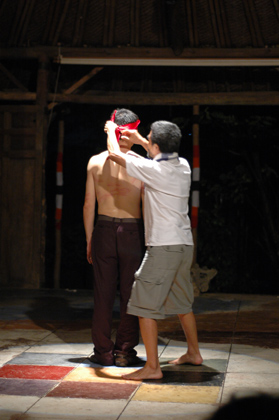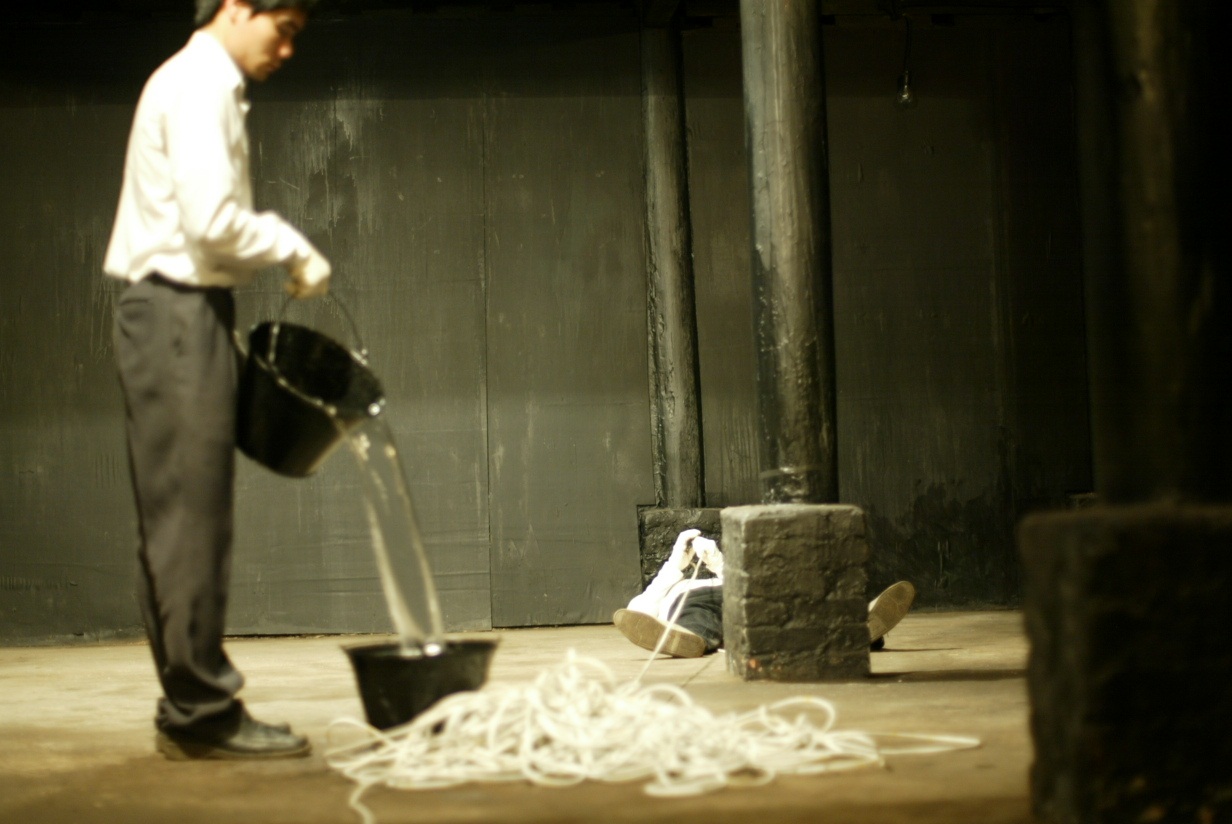Is performance art a sustainable approach in the contemporary art scene in Viet Nam?

Quỳnh Nguyễn explores the sustainability of performance art in Viet Nam, highlighting its evolution, challenges, and the unique role it plays in a society with many limitations on expression. Performance art, by its very nature, has always been creating many multidimensional perspectives. However, facing the abundance of materials, the greed of feelings or the lack of ideas, this art form is still a potential approach with high sustainability to adapt flexibly in the context of contemporary art.
This article is commissioned as part of culture360.ASEF.org's Going beyond 'green' open call. Through a series of articles and podcasts, we look at various endeavours, insights and trends that broaden the discourse of sustainability beyond the environmental aspect within the arts and culture sector.
The Nature of Performance Art
A rare document on performance art in Vietnamese from Nhà Sàn Collective, one of the spaces that have been actively supporting performance artists in Viet Nam, once stated: Performance art challenges the orthodox notion of “real art” by flexibly adapting to many different situations and challenging the “materiality” of art when art itself is not an object similar to a sculpture or a traditional easel painting. (1)
The primary material of the performance is the artist’s body; thus, it is highly focused on individual behaviors and impromptu reactions to the surrounding context and audience. Though in many works of performance art, artists incorporate other supporting media such as sound, installation, video, etc., most fundamentally, the performance still focuses on the human instinct of movement by means of the artist’s body and only minimal use of objects.
The birth of performance art challenges the focus on props and space in order to honour the most original material: the human body and human reason. Looking back at the history of outstanding works of performance art in Vietnam, many artists have left their mark on movements with minimalist materials, reserving the spotlight on the behaviors and reactions of their bodies. The work is considered to be the beginning of the history of performance by the artist duo Nguyễn Văn Tiến and Trần Anh Quân when using gauze, mats and paint at the Temple of Literature (Hanoi), focusing on the body to convey the theme of life and death. (2) Or to the work performed in different countries by artist Trần Lương with only a red scarf, leaving space for the audience’s impromptu response to his body. (5) At the same time, as the artist performs, the unpredictable developments of his physical body become diverse variations, fostering new dialogues and constructive conflicts, something that other forms of art might not be able to do.
Besides the material, performance art’s flexibility and versatility lie in its space of occurrence. Any space that evokes the artist’s senses can be a sacred stage for performing. In a study on performance art in Viet Nam, Dr. Nora Taylor once commented: “Performance art lends itself easily to experimentation because it can take place anywhere.” (3)
In Vietnam, during the early development of performance art, Nhà Sàn Studio on Bưởi street served as an experimental space for the generation of pioneering performance artists such as Trần Lương, Trương Tân, Nguyễn Mạnh Hùng, Nguyễn Minh Phước, etc. Later on, the sacred stages of performance artists became more diverse, from a dark coal mine in Quảng Ninh to a desolate resettlement area next to the Huế Citadel, or an isolated room in Saigon. Art is now no longer limited to places such as museums, cultural centers, and artist studios; instead, it has been weaving its way into every corner of daily life.

1. A durational performance "Welts" by artist Tran Luong uses only one red scarf © studio plesungan
Nurturing Inherent Sustainability
Suppose sustainability only stops at the realm of material, understood as using environmentally friendly materials or building works that integrate direct meaning, art would be easily impoverished in that case because it is not thought-provoking and reflective. However, even more fundamental is that sustainability be stored in the artist’s ideas manifested by the work. Is there a material more sustainable than the human body, a sacred entity that the artist nurtures in every moment that passes by? Is there any concept that lasts longer with the artist than his thoughts? Is there any better practice than the ability to focus on behaviors even in everyday life?
Dr. Nora once commented: “Works of performance art often find it difficult to answer the question: what does it mean in the end? Instead, people are amazed by the technical effects of the performance, perhaps they are attracted to it as something beyond what is normal”. Unlike admiring a painting or an installation, when watching a performance, the audience goes through different emotions, from waiting curiously to feeling excited about what might happen next, then somewhat distraught as the performance ends, and the lingering nostalgia of the ephemerality it creates. Even the artist, in the process of performing, continuously discovers new limits of his body, allowing them to keep experimenting and allowing their emotions to grow. As he was sharing in a programme celebrating 20 years of the development of performance art at the APD Center, artist Trần Lương gave his comment: “Performance art can connect with the inner and outer worlds at the highest level of all art forms, because it uses all the senses to dialogue with the surrounding life, with the weather, humidity, with nature, political and social atmosphere, etc.” (4)
In a conversation, Châu Nhi, a young artist from Huế, Viet Nam, shared that though she pursued painting at her university, she is now choosing to develop her career in performance art: “In the beginning, when I watched the behaviors and gestures of the senior performance artists, I always wondered why it moved me so much; I did not know where the feeling came from but it kept pushing me to learn and get to know that art more. Until I actually practiced, the changes in my senses gave me a feeling of familiarity, of roughness, but truly real.”
Is it true that each participant’s flourishing of emotions and thinking, when a performance takes place and even when it ends, has always been the lasting value that art seeks?

2. Performances by veteran performance artist collective Appendix often focus on human behavior or reason, with the aid of simple objects © Nha San collective
Challenges of performance art to establish sustainability in Viet Nam
Performance art in Viet Nam has gone through many different stages of transformation. After the 2000s, many performances appeared in official events after a period of practice in independent and small spaces. In recent years, performance art has gathered its own audience through different channels such as workshops and performance tours, mostly guerrilla-like in their organisation due to censorship or financial limitations.
In Viet Nam, where freedom of expression is rather limited, certain genres, such as visual or performance art, may encounter particular barriers in terms of appreciation. In that correlation, performance art, with its guerrilla nature in its performing space and its mutation in form, can allow artists to experiment as flexibly as possible to evoke more feelings in the audience. Artist Trần Lương agrees that “the sustainability of performance art is not a question of its existence and its future, but rather of its nature with all the diversity and biological forms entailed, regardless of social and political conditions.”
Performance artists, not much different from artists in other fields in the journey of artistic creation, must constantly practice to renew themselves. Besides materials from the body or daily observations, artists must experiment with many other materials. “Although I consider performance art the core form of my practice, I do not limit myself to a certain material but still experiment with many other materials. I consider this an important factor for artists to be able to explore and appeal to their senses.” said performance artist Dương Thanh Quang.

3. Performance “Have a taste” by young artist Duong Thanh Quang within the framework of the INACT 2022 performance event, focusing on his body's reactions with the daily life materials like wastewater, vegetables, soil © Á Space
Artist Vũ Đức Toàn, curator and member of the independent performance group Phụ Lục (The Appendix), also commented that cultivating and renewing oneself is something that art practitioners cannot ignore. A skilled performance artist is one sensitive to different situations, materials and interactions. They will need a deeper understanding of their physical space during a performance, with a clear perception of time, rhythm, and intensity. Equally important is their ability to foresee potential problems that may occur as they perform.
At the same time, peripheral factors should also be taken into account to better support performance artists in Viet Nam, especially in terms of funding and censorship activities so that performance artists can carry out their practices properly. Unlike other art forms with certain sanctions and standards, performance art, with more than 20 years of age, is still looking for specific support. This presents a challenge both difficult and exciting for artists and performance art supporters in Viet Nam to continue the vibrant life of performance art through unceasing dialogues and negotiations. (4)
About the Author
Quỳnh Nguyễn is an independent writer based in the central part of Vietnam. Her projects focus on marginalized groups in contemporary Vietnamese society in vulnerable contexts such as climate change, cultural decline, and inequality. She is now the co-founder of Thì Collective, a family network of writers, translators, artists or community workers who utilize the arts as a vehicle to discover the stories of marginalized communities in precarious situations such as climate change, gender inequality, cultural degradation. Their forms range from sketching, photography, documentary, text and performances to convey the stories we heard or witnessed from vulnerable communities.
References
(1) GIỚI THIỆU VỀ NGHỆ THUẬT TRÌNH DIỄN VIỆT NAM | A DRAFT OVERVIEW OF VIETNAMESE PERFORMANCE ART. (2010, September 23). IN:ACT Sự Kiện Nghệ
Thuật Trình Diễn Quốc Tế | International Performance Art Event. https://inactevent2010.wordpress.com/3-giới-thiệu-về-nghệ-thuật-trinh-diễn-việt-nam-a-draft-overview-of-vietnamese-performance-art/
(2) Recap: “DISCUSSION ON THE SOCIO-POLITICAL SITUATION AND PERFORMANCE ARTS/THE PROBLEM OF ORGANIZING ART EVENTS” (Hay Là Collective) https://www.instagram.com/p/CmsURSEoHhQ/
(3) Taylor, N. A. (2016). Vietnamese Anti-art and Anti-Vietnamese Artists: Experimental Performance Culture in Hà Nội's Alternative Exhibition Spaces. https://www.academia.edu/30186468/Vietnamese_Anti_art_and_Anti_Vietnamese_Artists_Experimental_Performance_Culture_in_H_N_i_s_Alternative_Exhibition_Spaces
(4) Talk “The development of performance art in Vietnam: an over-20 year review”; APD (Center for Art Patronage and Development). https://apd.org.vn/en/library/event-program/elementor-4856/
